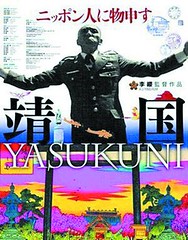Film Review: Yasukuni
 映画:「靖国」
映画:「靖国」Kyoto's Doshisha University screened the documentary film Yasukuni (2007) last week at its Imadegawa Campus's Hardy Hall. Following the film, Director Li Ying answered questions in a symposium.
Yasukuni Shrine is of course the most controversial place of worship in all of Japan. The reason is that it is the resting place of Japan's war dead, among them fourteen Class A war criminals including Hideki Tojo.
It is where Japan commemorates the end of the war every August 15th - and is a magnet for rightists. It is also a lightning rod for China, the Koreas, and Taiwan, for whom it represents Japan's unrepented past.
The film was released in April 2008 and soon became a cause celebre for nationalists in Japan. Threats of violence caused movie theaters in Tokyo and Osaka to drop the film.
The film received 7.5 million yen from the Japan Arts Council and was made by a mix of Chinese and Japanese staff - but was criticized as being biased, primarily because Li is Chinese.
A lawmaker, Tomomi Inada, even called for a boycott of the movie. The film was however eventually shown without incident.
One wonders though if Inada and the rightists actually saw the film, or if rather they were reflexively opposing a depiction of Yasukuni of any kind by a non-Japanese. Had they seen the film their concerns may have been allayed.
The film begins with 90-year-old swordmaker Naoji Kariya, the maker of the official sword for the Shrine. Director Li Ping weaves interviews with Kariya in with footage of the scene at the shrine on August 15, 2006.
Much of the film is the above interviews or unedited footage of cranks. The usual suspects - rightists, the war dead association, and assorted whack jobs - are out in force.
The most compelling part of the film is a 20-minute sequence in which two young men (one Chinese, one Japanese) who - having interrupted the solemn ceremony following right-wing Tokyo governor Shintaro Ishihara's speech - are chased away and bloodied by a mob before the police manage to take them to safety.
Otherwise, it is overlong takes - often off angle - of people with a limited grasp of reality. One example is of an American real estate broker who claims to have flown in from Nevada to show his support for then Prime Minister Junichiro Koizumi. He is wearing his realtor uniform - sunglasses, pressed slacks, button down shirt, and tie - and holding a sign in Japanese that says "I support Koizumi" and in his other hand a US flag.
The man is either a paid actor or an absolute nut, and this is a bearded lady at the circus type attraction that adds nothing to a discussion of the issues surrounding the War, memory thereof, and Japan's strained relations with its neighbors more than six decades after the war ended.
The "realtor" speaks no Japanese and arrives in Japan, on August 15th, from Nevada to demonstrate in favor of the right wing Koizumi government? After 15-plus minutes of watching him babble with older Japanese men - some of whom support his stance - he too is escorted off the grounds of the Shrine by the police for his own safety.
The man to my right slumped to sleep at this point.
From there it is back to Kariya's sword studio for more unedited interviews. Embarassingly, the Director - who has lived in Japan for some twenty years - had trouble understanding the taciturn Kariya. Why was this footage left in the film?
Cinema verite?
More realism ensued with scenes filmed with a filthy lens. Again, why were these scenes left in the film?
The film was too long, its message unclear, and unfortunately only adds more confusion to a place that still resonates with many in East Asia. If you doubt that, check back on August 15th.
Photo © Wikipedia
Yahoo Japan Auction Service
Book a Japanese Hotel with Bookings
Japanese Friends
Rough Guide To Japan
Tags
Japan Tokyo Kyoto Yasukuni Japanese
コメントを投稿